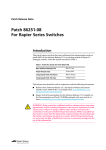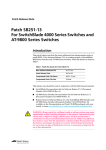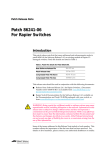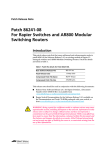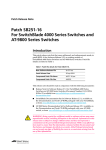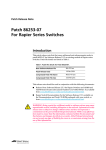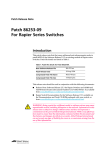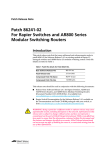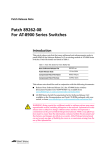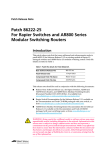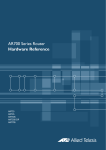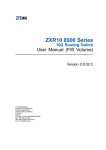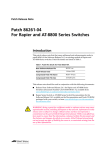Download Allied Telesis 86251-05 Network Router User Manual
Transcript
Patch Release Note
Patch 86251-05
For Rapier Switches and AR800 Series
Modular Switching Routers
Introduction
This patch release note lists the issues addressed and enhancements made in
patch 86251-05 for Software Release 2.5.1 on existing models of Rapier L3
managed switches and AR800 Series L3 modular switching routers. Patch file
details are listed in Table 1.
Table 1: Patch file details for Patch 86251-05.
Base Software Release File
86s-251.rez
Patch Release Date
15-May-2003
Compressed Patch File Name
86251-05.paz
Compressed Patch File Size
320764 bytes
This release note should be read in conjunction with the following documents:
■
Release Note: Software Release 2.5.1 for Rapier Switches, and AR800 Series
Modular Switching Routers (Document Number C613-10354-00 Rev A)
available from www.alliedtelesyn.co.nz/documentation/documentation.html.
■
Rapier Switch Documentation Set for Software Release 2.5.1 available on
the Documentation and Tools CD-ROM packaged with your switch, or
from www.alliedtelesyn.co.nz/documentation/documentation.html.
WARNING: Using a patch for a different model or software release may cause
unpredictable results, including disruption to the network. Information in this
release note is subject to change without notice and does not represent a
commitment on the part of Allied Telesyn International. While every effort has
been made to ensure that the information contained within this document and
the features and changes described are accurate, Allied Telesyn International
can not accept any type of liability for errors in, or omissions arising from the
use of this information.
Sim ply connectin g th e wo rld
2
Patch Release Note
Some of the issues addressed in this Release Note include a level number. This
number reflects the importance of the issue that has been resolved. The levels
are:
Level 1
This issue will cause significant interruption to network services, and
there is no work-around.
Level 2
This issue will cause interruption to network service, however there
is a work-around.
Level 3
This issue will seldom appear, and will cause minor inconvenience.
Level 4
This issue represents a cosmetic change and does not affect network
operation.
Features in 86251-05
Patch 86251-05 includes all issues resolved and enhancements released in
previous patches for Software Release 2.5.1, and the following enhancements:
PCR: 02583
Module: FIREWALL
Level: 2
UDP packets passed through the firewall by a reverse enhanced NAT rule
were getting an incorrect IP checksum. This caused IP to discard the
packets. This issue has been resolved.
PCR: 03059
Module: FIREWALL
Level: 2
SMTP proxy was falsely detecting third party relay under some
circumstances. This issue has been resolved.
PCR: 03095
Module: DHCP
Level: 2
DHCP policies are no longer stored in alphabetical order in the DYNAMIC
CONFIGURATION script because this did not work when the DHCP
INHERIT parameter was used.
PCR: 03148
Module: IPG
Level: 3
If the Gratuitous ARP feature was enabled on an IP interface, and an ARP
packet arrived, (either ARP request, or reply) that had a Target IP address
that was equal to the SenderIP address, then the ARP cache was not
updated with the ARP packet’s source data. This issue has been resolved.
PCR: 03177
Module: IPG
Level: 3
Deleting an IP MVR group range would only delete the last IP address of
the range from the multicast table, not the entire range. This issue has been
resolved.
PCR: 03199
Module: IPV6
Level: 3
RIPng was receiving invalid routes and packets. This issue has been
resolved.
PCR: 03241
Module: FIREWALL
Level: 3
When deleting a list associated with a policy, all rules were being deleted.
Now only the rules associated with the policy and list are deleted.
Patch 86251-05 for Software Release 2.5.1
C613-10356-00 REV F
Patch 86251-05 For Rapier Switches and AR800 Series Modular Switching Routers
PCR: 03270
Module: SWI
3
Level: 3
The inter-packet gap has been reduced by 4 bytes on the Rapier 48i stacking
link. This allows for non-blocking operation with tagged packets.
PCR: 03299
Module: IKMP
Level: 2
Under some circumstances, ISAKMP suffered a fatal error if more than 8 SA
proposals were presented. This issue has been resolved.
PCR: 03314
Module: SWI
Level: 2
Layer 3 filters that matched TCP or UDP port numbers were being applied
to the second and subsequent fragments of large fragmented packets. This
issue has been resolved.
PCR: 03354
Module: FIREWALL
Level: 3
The SET FIREWALL POLICY RULE command was not accepting the value
24:00 (midnight) for the BEFORE parameter. This issue has been resolved.
PCR: 03371
Module: DHCP
Level: 3
A minimum lease time can no longer be specified when creating a DHCP
policy. This complies with RFC 2131.
PCR: 03383
Module: IPG
Level: 2
If there were a large number of routes in the route table, and the SHOW IP
ROUTE command was executed, the device stopped operating. This issue
has been resolved.
PCR: 03390
Module: HTTP
Level: 2
Occasionally a fatal error occurred when the GUI browser started or a page
was refreshed. This issue has been resolved.
PCR: 03392
Module: IPSEC, IKMP
Level: 3
IPV4 is the default for the IPVERSION parameter in the CREATE IPSEC
POLICY and CREATE ISAKMP POLICY commands. This default was
unnecessarily displayed in the SHOW CONFIGURATION DYNAMIC
command output. This issue has been resolved.
PCR: 03395
Module: BGP
Level: 3
The amount of time that BGP peers ‘back off’ for after changing from the
ESTABLISHED state to the IDLE state has been changed. Previously, this
‘back off‘ time grew exponentially and never decayed. The ‘back off‘ time is
now always one second.
PCR: 03396
Module: ETH
Level: 3
Some memory was lost on the AT-AR022 ETH PIC when hotswapping. This
issue has been resolved.
PCR: 03400
Module: SSL
Level: 3
Sometimes SSL did not allow its TCP session to close properly. This
happened if the Fin packet was not piggy-backed on a data packet, or if the
SSL Handshake was never completed with the far end. This meant that the
closing Alert was not sent, so the session could not close. Also, SSL leaked
memory when it received invalid SSL records. These issues have been
resolved.
Patch 86251-05 for Software Release 2.5.1
C613-10356-00 REV F
4
Patch Release Note
PCR: 03402
Module: IPG
Level: 2
IP routes deleted from the route cache occasionally caused a fatal error. This
issue has been resolved.
PCR: 03405
Module: STREAM
Level: 2
The reconnection to the stream printing TCP port failed after a single
successful connection was made. This issue has been resolved.
PCR: 03407
Module: IPG
Level: 3
The default for the PROXYARP parameter in the SET IP INTERFACE
command for a VLAN interface was OFF. The default is now ON.
PCR: 03410
Module: VLAN, CORE
Level: 3
If a patch was running with a major software release, after a VLAN was
added at the command line, the VLAN was not shown as UP. This issue has
been resolved.
PCR: 03412
Module: FIREWALL
Level: 3
FTP data transfers did not succeed for some types of NAT. Also, the
presence of flow control TCP flags meant that some TCP control packets
were not recognised. These issues have been resolved.
PCR: 03413
Module: BGP
Level: 2
BGP was updated according to the most recently added route. BGP now
updates to reflect the best available route, regardless of when it was added.
PCR: 03415
Module: FIREWALL
Level: 2
When using a policy routing rule, the firewall did not translate the source
IP address of a broadcast packet correctly. This issue has been resolved.
PCR: 03416
Module: SWI
Level: 3
Previously, the ADD SWITCH L3FILTER MATCH command was accepted
if the TYPE parameter was not specified. This command now requires the
TYPE parameter, and an error message will be returned if the TYPE
parameter is not specified.
PCR: 03424
Module: DHCP
Level: 2
When static DHCP was set to the first IP address in a range, that range
would stay in the Reclaim mode. This issue has been resolved.
PCR: 03426
Module: IPV6
Level: 3
If the valid and preferred lifetimes of an IPv6 address for a given interface
were set to infinity, they were not included in the dynamic configuration.
This issue has been resolved.
PCR: 03429
Module: SWI, VLAN
Level: 3
The SHOW VLAN command was displaying a port that did not exist. This
issue has been resolved.
Patch 86251-05 for Software Release 2.5.1
C613-10356-00 REV F
Patch 86251-05 For Rapier Switches and AR800 Series Modular Switching Routers
PCR: 03430
Module: BGP
5
Level: 3
BGP traps were sent incorrectly when a BGP peer became Established, or
moved into a lower state. This issue has been resolved.
PCR: 03432
Module: STP
Level: 2
STP settings were not retained when a port was deleted from the VLAN that
the STP belongs to. This issue has been resolved.
PCR: 03436
Module: IP, DHCP
Level: 2
When the device was acting as a DHCP client and the DHCP server
provided a gateway address, a statically configured default route was
deleted and replaced with a default route with the provided gateway
address. The correct behaviour is to only delete a dynamic default route in
this situation. This issue has been resolved; the correct behaviour is now
applied.
PCR: 03439
Module: IPX
Level: 3
The IPX traffic filter match counter was not incremented if a route was
cached. This issue has been resolved.
PCR: 03441
Module: L2TP
Level: 2
PPP configured on a L2TP access concentrator (LAC) should be dynamic. If
PPP was incorrectly configured to be static, the static PPP was destroyed
when the L2TP tunnel was formed so that only the first connection
succeeded. This issue has been resolved so that an L2TP tunnel is not
created if the PPP is static.
PCR: 03443
Module: DHCP
Level: 3
When a DHCP entry expired while other DHCP entries in the range were in
Reclaim mode, unnecessary ARP packets were generated causing an ARP
storm. This issue has been resolved.
PCR: 03444
Module: FR
Level: 3
The CIR and CIRLIMITED parameter in the SET FRAMERELAY DLC
command now regulates the behaviour of the transmission rate. Previously,
the transmission rate did not reflect changes to the CIR setting if the new
CIR was higher than the old CIR (provided that the new CIR is within the
physical maximum of the network and the hardware), or changes to the
CIRLIMITED setting if CIRLIMITED was turned ON then OFF. This issue
has been resolved.
PCR: 03446
Module: SWI
Level: 3
After unplugging a fibre uplink cable and then plugging it back in, a short
Ping timeout occurred. This issue has been resolved.
PCR: 03450
Module: PIM, PIM6
Level: 2
Receiving PIM State Refresh messages now creates and/or maintains PIM
forwarding information.
PCR: 03453
Module: FIREWALL
Level: 3
The dropped packets counter for the firewall was not incrementing
correctly. This issue has been resolved.
Patch 86251-05 for Software Release 2.5.1
C613-10356-00 REV F
6
Patch Release Note
PCR: 03454
Module: IPV6
Level: 3
Occasionally, removing the cable from an IPv6 interface caused the device
to stop responding. This issue has been resolved.
PCR: 03456
Module: PIM
Level: 2
A VLAN interface receiving a PIM Prune message on a port stopped
forwarding multicast data to that port too early. This could cause multicast
data to arrive after a PIM Prune, so an override PIM Join message was not
sent, leading to a loss of multicast data. This issue has been resolved.
PCR: 03457
Module: OSPF
Level: 2
Disabling OSPF caused a fatal error if there was a large routing table. This
issue has been resolved.
PCR: 03459
Module: IPV6
Level: 2
A fatal error sometimes occurred when packets were forwarded via an IPv6
interface, and IPv6 flows were disabled. This issue has been resolved.
PCR: 03461
Module: IPG
Level: 3
The ENABLE IP MVR DEBUG=ALL command was erroneously shown in
the output of the SHOW CONFIG DYNAMIC=IP command. This SHOW
output no longer includes the ENABLE IP MVR DEBUG=ALL entry.
PCR: 03462
Module: PIM, PIM6
Level: 3
PIM Graft and Graft-Ack counters were not incrementing. This issue has
been resolved.
PCR: 03465
Module: DHCP
Level: 3
The IPMTU parameter in the ADD DHCP POLICY command was
accepting values in the range 0-4294967295. This parameter now accepts
values in the correct range of 579-65535.
PCR: 03463
Module: PIM, PIM6
Level: 3
PIM-SM Null register messages did not update the register counter
correctly, and did not trigger Register debug messages. This issue has been
resolved.
PCR: 03464
Module: PIM, PIM6
Level: 3
PIM-SM Null register messages for non-PIM-SM domain sources did not
have the Border bit set. This issue has been resolved.
PCR: 03467
Module: IPG
Level: 3
An invalid message appeared when the PORT parameter was specified for
the ADD IP ROUTE command. This issue has been resolved.
PCR: 03471
Module: IPV6
Level: 2
A fatal error sometimes occurred when forwarding traffic over an IPv6
tunnel. This issue has been resolved.
Patch 86251-05 for Software Release 2.5.1
C613-10356-00 REV F
Patch 86251-05 For Rapier Switches and AR800 Series Modular Switching Routers
PCR: 03473
Module: PIM, PIM6
7
Level: 3
The SET LAPD MODE=NONAUTOMATIC command did not change the
LAPD mode from automatic to non-automatic. This issue has been
resolved.
PCR: 03474
Module: FIREWALL
Level: 3
The SMTP proxy did not correctly allow outgoing (private to public) SMTP
sessions when the DIRECTION parameter was set to OUT or BOTH in the
ADD FIREWALL PROXY command. This issue has been resolved.
PCR: 03475
Module: NTP
Level: 3
The PURGE NTP command did not change the UTC offset to the initialised
value. This issue has been resolved.
PCR: 03476
Module: IPV6
Level: 3
RIPng was showing routes to interfaces that were DOWN as being UP. This
issue has been resolved.
PCR: 03478
Module: PIM, PIM6
Level: 3
The message format for PIM-SM periodic (*,*,RP) Join messages was
incorrect when the message contained more than one joined RP address.
This issue has been resolved.
PCR: 03484
Module: FIREWALL
Level: 3
The firewall was not denying an ICMP packet, even if ICMP Forwarding
was disabled when using Standard NAT. This issue has been resolved.
PCR: 03492
Module: HTTP, LOAD
Level: 2
Some memory loss occurred when loading a file via HTTP. This issue has
been resolved.
PCR: 03494
Module: BGP, FIREWALL
Level: 2
If the firewall was enabled when BGP was in use outgoing BGP data packets
would have IP header errors and incorrect checksums. This problem has
now been fixed.
PCR: 03497
Module: PIM, PIM6
Level: 2
In a network with an alternative path, if the link connected to the interface
where a Candidate Rendezvous Point (CRP) advertised its RP candidacy
was down, the CRP did not re-advertise its RP candidacy on other available
interfaces (the alternative path). This meant that the CRP did not update its
PIM routes, which was necessary to re-establish the PIM tree in order for
multicast data to flow again. This issue has been resolved.
PCR: 03498
Module: SWI
Level: 3
The SHOW SWITCH FDB command showed a number of irrelevant entries.
This issue has been resolved.
Patch 86251-05 for Software Release 2.5.1
C613-10356-00 REV F
8
Patch Release Note
PCR: 03502
Module: IPG
Level: 3
The ENTRY parameter from the ADD IP FILTER command was not
included in the output of the SHOW CONFIG DYNAMIC command. This
issue has been resolved.
PCR: 03513
Module: IPG
Level: 3
An enhancement allows for the creation of static IGMP group memberships
that do not time out. For details on this feature, see “Static IGMP” on
page 24.
PCR: 03515
Module: DHCP
Level: 3
DHCP was offering network and broadcast addresses to clients. This issue
has been resolved.
PCR: 03517
Module: FIREWALL
Level: 3
An error was not returned if the SET FIREWALL POLICY RULE command
was executed with PROTOCOL=1 when ICMP forwarding was turned on.
This issue has been resolved so that an error is now displayed.
PCR: 03523
Module: FIREWALL
Level: 2
In some circumstances the checksum for the TCP header was set to zero.
This issue has been resolved.
PCR: 03526
Module: SWI
Level: 3
The Switch MIB did not show the correct dot1StpPriority value. This issue
has been resolved.
PCR: 03531
Module: SWI
Level: 3
After creating a trunk group, the activity LEDs did not flash unless the
configuration was used at reboot. This issue has been resolved so that the
LEDs flash correctly whenever a trunk group is created.
PCR: 03468
Module: PIM
Level: 3
The source IP address in a PIM Register message was not the DR interface’s
IP address. This issue has been resolved.
PCR: 03533
Module: PIM
Level: 3
A forwarded PIM-DM state Refresh message did not update the metric and
preference values. This issue has been resolved.
PCR: 03535
Module: IPG
Level: 2
IGMP Query messages were not sent after IGMP was disabled and then reenabled. This issue has been resolved.
Patch 86251-05 for Software Release 2.5.1
C613-10356-00 REV F
Patch 86251-05 For Rapier Switches and AR800 Series Modular Switching Routers
9
Features in 86251-04
Patch file details are listed in Table 2:
Table 2: Patch file details for Patch 86251-04.
Base Software Release File
86s-251.rez
Patch Release Date
15-April-2003
Compressed Patch File Name
86251-04.paz
Compressed Patch File Size
240936 bytes
Patch 86251-04 includes all issues resolved and enhancements released in
previous patches for Software Release 2.5.1, and the following enhancements:
PCR: 02571
Module: IP
Level: 3
A fatal error occurred if the IP module was reset after the ADD IP EGP
command was executed. This issue has been resolved.
PCR: 02577
Module: IPG, LOG
Level: 4
The ability to log MAC addresses whenever the ARP cache changes has
been added. To enable this, use the command:
ENABLE IP ARP LOG
To disable it, use the command:
DISABLE IP ARP LOG
The logging of MAC addresses is disabled by default. Use the SHOW LOG
command to view the MAC addresses that have been logged when the ARP
cache changes.
PCR: 03025
Module: GUI
Level: 2
A buffer address was incrementing and not returning buffers for reuse
when the command line interface was accessed via the GUI interface. This
issue has been resolved.
PCR: 03044
Module: BGP
Level: 2
During route flapping, peers were sometimes not told about routes to the
same destinations as the flapping routes. This issue has been resolved.
PCR: 03048
Module: STP
Level: 2
If a port belongs to an enabled STP instance, but the port has been disabled
from STP operation with the DISABLE STP PORT command, the port will
not respond to ARP requests. This patch implements a workaround that
allows disabled STP ports to respond to ARP requests.
PCR: 03089
Module: CORE
Level: 4
The SET SYSTEM NAME command was accepting character strings greater
than the limit of 80 characters. This issue has been resolved.
PCR: 03094
Module: STP, VLAN
Level: 3
The VLAN membership count for STP ports was incorrect in the default
configuration. This issue has been resolved.
Patch 86251-05 for Software Release 2.5.1
C613-10356-00 REV F
10
Patch Release Note
PCR: 03096
Module: VLAN
Level: 2
OSPF and RIP Hello packets were being sent out all trunked ports. Now
these Hello packets are only sent out the master port of the trunked group.
PCR: 03097
Module: IPV6
Level: 3
A device could not Telnet to a device outside its own subnet. This issue has
been resolved.
PCR: 03098
Module: PIM, DVMRP, IPG
Level: 2
When multicasting in hardware, the switch would not forward packets
from a VLAN ingress interface to a non-VLAN interface downstream. This
issue has been resolved.
PCR: 03105
Module: FIREWALL
Level: 3
Incorrect handling of TCP sessions, and poor load balancing performance
could be caused by TCP virtual balancers not selecting a new resource if
required. This issue has been resolved.
PCR: 03109
Module: LOG
Level: 3
A log was only partially created if there was insufficient NVS memory for
log creation on the router. A change has been made so that a log is not
created if there is insufficient memory, and a warning message is displayed.
PCR: 03110
Module: IPG
Level: 3
An error occurred with the ADD IP MVR command. This issue has been
resolved. Also, this command accepted any IP addresses for the GROUP
parameter, but now only accepts multicast addresses.
PCR: 03111
Module: FIREWALL
Level: 1
TCP sessions could fail if the public side of the firewall was using Kerberos
and the private side had a very slow connection to the firewall. This issue
has been resolved.
PCR: 03115
Module: PING
Level: 3
The SHOW CONFIG DYNAMIC=PING command was giving an incorrect
port number. This issue has been resolved.
PCR: 03116
Module: FIREWALL
Level: 2
An error sometimes occurred in the firewall module under heavy FTP or
RTSP traffic loads. This issue has been resolved.
PCR: 03117
Module: FIREWALL
Level: 1
The TCP sequence numbers are no longer altered through the firewall when
TCPSETUP is disabled with the DISABLE FIREWALL POLICY command.
PCR: 03119
Module: CLASSIFIER
Level: 4
TCP source and TCP destination ports were swapped when viewed in the
GUI. This issue has been resolved.
Patch 86251-05 for Software Release 2.5.1
C613-10356-00 REV F
Patch 86251-05 For Rapier Switches and AR800 Series Modular Switching Routers
PCR: 03120
Module: ETH, IPG
11
Level: 4
The SHOW IP INTERFACE command was showing ETH interfaces as up at
startup, when SHOW INTERFACE and SHOW ETH STATE had them as
down. This issue has been resolved.
PCR: 03124
Module: IPV6
Level: 4
The SHOW IPv6 COUNTER command now shows the outAdvert messages
in the Total Out Messages counter field.
PCR: 03132
Module: SWITCH
Level: 2
Classifiers that were added to hardware filters were not applied to the
hardware. This issue has been resolved.
PCR: 03139
Module: IPV6
Level: 3
The SHOW IPV6 INTERFACE command was not displaying the link layer
address and EUI when the interface was down. This issue has been
resolved.
PCR: 03140
Module: IPG, SWI
Level: 2
Static ARPs were deleted when a port went down. This issue has been
resolved.
PCR: 03144
Module: CURE
Level: 4
Users with either USER or MANAGER level privilege can now execute the
STOP PING and STOP TRACE commands. Previously, MANAGER
privilege was needed to execute these commands.
PCR: 03145
Module: IPG
Level: 4
The SET IP ROUTE FILTER command was not processing some parameters.
This issue has been resolved.
PCR: 03146
Module: PORT
Level: 4
The PAGE parameter in the SET ASYN command now only accepts
numeric values between 0 and 99, ON or OFF, and TRUE or FALSE.
PCR: 03147
Module: BGP
Level: 4
When the DISABLE BGP DEBUG command was used, debugging messages
were still being displayed by the BGP module. This issue has been resolved.
PCR: 03149
Module: SWITCH
Level: 3
When the Layer 3 Filter Match entry IMPORT was created, EPORT could be
set on the filter entry. If the Layer 3 Filter Match entry EMPORT was created,
then IPORT could be set on the filter entry. Setting parameters that did not
match could cause undesirable results. This issue has been resolved.
PCR: 03150
Module: FIREWALL
Level: 3
The CREATE FIREWALL POLICY command was not checking for valid
name entries, so invalid printing characters could be used for policy names.
This issue has been resolved.
Patch 86251-05 for Software Release 2.5.1
C613-10356-00 REV F
12
Patch Release Note
PCR: 03152
Module: IPG
Level: 3
An additional check has been added to validate the MASK specified in an
ADD IP ROUTE command. The check tests that the mask is contiguous.
PCR: 03153
Module: ACC
Level: 4
The SHOW CONFIG=ACC command was not showing the rscript file. This
issue has been resolved.
PCR: 03154
Module: PCI
Level:
The SHOW IP MVR command output was showing dynamic members in
the incorrect column. This issue has been resolved.
PCR: 03155
Module: FFS
Level: 4
The SHOW FFILE command output has changed. The first column that
listed where the file was stored has been removed. The title of the original
second column (now the first column) has been changed from “creator” to
“module”. The file format specifier has been altered from:
DDDD:MMMM\NNNNNNNN.TTT
to:
MMMM\NNNNNNNN.TTT
PCR: 03157
Module: IPV6
Level: 3
When changing the ACTION parameter between INCLUDE and
EXCLUDE on IPV6 filters the interface information was not preserved
between changes. The interface information is now preserved.
PCR: 03159
Module: SWI
Level: 2
Switch trunk speed checks only checked for gigabit settings, not speed
capabilities. It is now possible for uplink modules which support 10, 000
and gigabit speed to attach to trunks where speeds are 10Mb/s or 100Mb/s.
PCR: 03162
Module: IPV6
Level: 3
The performance of IPv6 has been improved by introducing IPv6 flows.
PCR: 03163
Module: IPG
Level: 3
IGMP Snooping did not use DVMRP messages to identify a port. This issue
has been resolved.
PCR: 03166
Module: IPG
Level: 4
The output of the SHOW IP IGMP COUNTER and SHOW
IGMPSNOOPING COUNTER commands was incorrect. This issue has
been resolved.
PCR: 03167
Module: DVMRP
Level: 2
When multicasting to a VLAN interface, if more than 2 DVMRP neighbours
existed on a single port, and any one of those neighbours was pruned, the
multicast data would stop flowing to the port. This happened even though
it was still required for the remaining DVMRP neighbours. This issue has
been resolved.
Patch 86251-05 for Software Release 2.5.1
C613-10356-00 REV F
Patch 86251-05 For Rapier Switches and AR800 Series Modular Switching Routers
PCR: 03169
Module: IPV6
13
Level: 2
Duplicate Address Detection (DAD) was not sent on VLAN interfaces. This
issue has been resolved.
PCR: 03180
Module: IPG
Level: 3
If all 32 VLAN interfaces had IP addresses attached, only 31 VLANs could
be multihomed. Now all 32 VLAN interfaces with IP addresses can be
multihomed.
PCR: 03186
Module: CORE, FFS, TTY
Level: 3
When the QUIT option was chosen after the SHOW DEBUG command was
executed, the output did not immediately stop. This issue has been
resolved, but there may be a short delay before the command prompt
reappears.
PCR: 03187
Module: IPG
Level: 3
SNMP linkup traps were not all appearing due to too many outstanding
ARP requests. This issue has been resolved. IP now does not limit the
number of outstanding ARP requests.
PCR: 03189
Module: FIREWALL, LB
Level: 3
A fatal error occurred for the load balancer when there were no UP
resources in a resource pool. This issue has been resolved. Load balanced
TCP connections will now only retry SYNs once after 5 seconds. The round
robin selection algorithm will now select an UP resource in a resource pool
with only one UP resource, even if it was used for the last successful
connection.
PCR: 03194
Module: LB
Level: 3
Sometimes healthcheck pings were not sent to the load balancer resources.
This issue has been resolved.
PCR: 03195
Module: USER
Level: 3
When a user was logged in as MANAGER, and Telnet was set to OFF, and
the CREATE CONFIGURATION command was executed, Telnet would be
reset to ON on startup. This issue has been resolved.
PCR: 03196
Module: IPV6
Level: 3
The system became unstable if the ADD IPV6 TUNNEL command failed.
This instability was caused by the partially created tunnel entry not being
properly removed from the tunnel database. The tunnel entry is now
completely removed.
PCR: 03198
Module: PRI
Level: 3
The PRI interface would occasionally take a long time for the ifOperStatus
of the interface to become UP. This issue has been resolved.
PCR: 03203
Module: IPV6
Level: 3
RIPng was not sending a response back to a RIP request message. This issue
has been resolved.
Patch 86251-05 for Software Release 2.5.1
C613-10356-00 REV F
14
Patch Release Note
PCR: 03205
Module: DHCP
Level: 2
The following issues with DHCP have been resolved:
•
DHCP assigned an incorrect IP address to clients shifting from a relayed
to a non-relayed range. Gateway checks have been added to resolve this
issue.
•
DHCP clients shifting between relayed ranges were not always
recognised, and were occasionally allocated incorrect addresses.
•
DHCP offered entries did not time out after a NAK on a bad lease time
request.
PCR: 03206
Module: IPG
Level: 3
IPv4 filters now behave like IPv6 filters.
PCR: 03208
Module: FIREWALL
Level: 2
When the configuration script was created using the CREATE CONFIG
command, the GBLIP parameter in the ADD FIREWALL POLICY
command was listed twice. This caused the command to fail when the
device was restarted. This issue has been resolved.
PCR: 03211
Module: SWI
Level: 2
When the MARL table had been fully populated, the addition of another
multicast group caused an entry to be deleted, and the new entry was not
added. This issue has been resolved so that no more groups can be added
when the table is full.
PCR: 03212
Module: IPV6
Level: 3
The TRACE command was not working when using an ipv6 link-local
address. This issue has been resolved.
PCR: 03213
Module: IPSEC
Level: 3
A memory leak occurred when some IPSEC processes failed. This issue has
been resolved.
PCR: 03216
Module: PIM, PIM6
Level: 2
PIM4 and PIM6 were not sending Hello packets if the HELLOINTERVAL
was not a multiple of 10. This is set with the ADD PIM INTERFACE, ADD
PIM6 INTERFACE, SET PIM INTERFACE, and SET PIM6 INTERFACE
commands. This issue has been resolved.
PCR: 03222
Module: PIM, PIM6
Level: 2
If the RP candidate advertising time was set to a non-default value with the
ADVINTERVAL parameter in the SET PIM command, the hold time in the
message was not being updated correctly. This issue has been resolved.
PCR: 03229
Module: LOAD
Level: 3
Zmodem was not naming some loaded files. This issue has been resolved.
Patch 86251-05 for Software Release 2.5.1
C613-10356-00 REV F
Patch 86251-05 For Rapier Switches and AR800 Series Modular Switching Routers
PCR: 03232
Module: BGP
15
Level: 3
Values for the KEEPALIVE and HOLDTIME parameters in the ADD BGP
PEER and SET BGP PEER commands were not interacting correctly. This
issue has been resolved.
PCR: 03234
Module: IPG
Level: 3
The PURGE IP command did not remove ENABLE IP IGMP from the
configuration. This issue has been resolved.
PCR: 03236
Module: IPG
Level: 3
IGMP queries were being sent after IGMP was disabled. This issue has been
resolved.
PCR: 03237
Module: IPG
Level: 2
RIP Request packets for IPv4 were not being transmitted when the link came
up or when the switch restarted. This issue has been resolved.
PCR: 03238
Module: SWI
Level: 2
When RIP interfaces were deleted, the IP routes learned through those
interfaces were not timing out correctly. Now, all IP routes learned though
a RIP interface are removed when the RIP interface is deleted, and no
timeouts occur.
PCR: 03239
Module: QOS
Level: 2
QoS Traffic Class maximum bandwidth limiting was being overwritten by
the port or trunk maximum bandwidth value. This should only happen
when the Traffic Class maximum bandwidth has not been set manually with
the CREATE QOS TRAFFICCLASS MAXBANDWIDTH parameter. This
issue has been resolved.
PCR: 03240
Module: OSPF
Level: 2
A fatal error occurred when OSPF was under high load. This issue has been
resolved.
PCR: 03245
Module: SWI, IPG, PIM
Level: 2
Multicast streams would not commence forwarding immediately due to
IGMP packets initiated but not sent while a VLAN was changing from the
DOWN to UP state. Also, multicast streams could be received while the
VLAN was changing from DOWN to UP, causing a PIM Reverse Path
Forwarding unicast route lookup failure. This was due to the unicast route
being unusable as the VLAN was still considered down. These issues have
been resolved.
PCR: 03247
Module: MVR
Level: 4
The Joins and Leaves counters in the SHOW IP MVR COUNTER command
output did not count subsequent join or leave requests after the first join or
leave. This issue has been resolved.
PCR: 03250
Module: SWI
Level: 4
The DELETE SWITCH FILTER command did not work properly when the
ENTRY parameter was assigned a range with hyphen (“-”). This issue has
been resolved.
Patch 86251-05 for Software Release 2.5.1
C613-10356-00 REV F
16
Patch Release Note
PCR: 03252
Module: PIM
Level: 3
An assert storm sometimes occurred with PIM-DM. This issue has been
resolved.
PCR: 03255
Module: FIREWALL
Level: 3
The firewall doubled the IPSPOOF event timeout from 2 minutes to 4
minutes. This issue has been resolved.
PCR: 03256
Module: MLD
Level: 3
MLD did not respond correctly when it was in exclude mode and it received
a request block. This issue has been resolved.
PCR: 03259
Module: SWI
Level: 4
On a Rapier 24i, when large ping packets were forwarded through a port
with ingress limiting, the ping packets were dropped. This issue has been
resolved.
PCR: 03261
Module: VLAN, IPG
Level: 4
VLAN and IPG packet debugging has been restored.
PCR: 03262
Module: PPP
Level: 3
The CREATE CONFIGUATION command adds the PPP TEMPLATE LQR
parameter when LQR is enabled. But the configuration script always used
“LQR=ON” even when the LQR value was not the default. This meant that
if a user entered LQR=40, the configuration would represent LQR=ON. This
issue has been resolved.
PCR: 03266
Module: PIM
Level: 2
The handling of the upstream neighbour for a GraftACK message has been
corrected.
PCR: 03269
Module: IPG
Level: 4
IGMP reports sometimes contained errors because of MVR. This issue has
been resolved.
PCR: 03276
Module: IPG
Level: 3
ECMP routing was incorrectly selecting the first route of equal cost found
when retrieving routes that were not cached. This issue has been resolved.
PCR: 03277
Module: IPG
Level: 3
IGMP Proxy can now forward IGMP Reports.
PCR: 03285
Module: IPG
Level: 4
RIP packets can now contain up to 25 routes per packet instead of 24.
PCR: 03288
Module: L2TP
Level: 2
When a radius lookup performed by the L2TP Access Concentrator (LAC)
failed, the LAC attempted to disconnect the call from its tunnel. If the tunnel
had not been created, the device restarted. This issue has been resolved.
Patch 86251-05 for Software Release 2.5.1
C613-10356-00 REV F
Patch 86251-05 For Rapier Switches and AR800 Series Modular Switching Routers
PCR: 03291
Module: PPP
17
Level: 2
A PAP authentication failure with PPPoE could cause a fatal error. This
issue has been resolved.
PCR: 03292
Module: IP
Level: 3
When adding static routes with the ADD IP ROUTE command, the order of
the route in the route table was the reverse of the order entered. This issue
has been resolved.
PCR: 03293
Module: PPP
Level: 3
The MAXSESSION parameter of the SET PPP ACSERVICE command could
not be changed when the service was defined over a VLAN. This issue has
been resolved.
PCR: 03296
Module: IPG
Level: 2
Broadcast TCP packets were being processed by the device, causing fatal
errors when firewall SMTP Proxy was configured. Non-unicast TCP packets
are now dropped by IP.
PCR: 03298
Module: FIREWALL
Level: 3
The SHOW FIREWALL POLICY was not showing the correct debugging
items, as set with the ENABLE FIREWALL POLICY DEBUG command.
This issue has been resolved.
PCR: 03300
Module: FIREWALL
Level: 3
Firewall rules were not being applied to broadcast packets received on a
public interface. This issue has been resolved.
PCR: 03302
Module: SWI
Level: 3
Following a period of high traffic load, the CPU utilisation would
occasionally fail to drop below 40%. This issue has been resolved.
PCR: 03306
Module: IPG
Level: 3
IGMP Proxy was setting a delay timer of 1-100 seconds when replying to an
IGMP query with a requested maximum delay of 10 seconds. This issue has
been resolved.
PCR: 03307
Module: IPG
Level: 3
IGMP Proxy did not disable the DR status of an existing IGMP interface
when that interface became the IGMP Proxy Upstream. IGMP Proxy also
did not enable the DR status of an interface when it became anything other
than the IGMP Proxy Upstream. These issues have been resolved.
PCR: 03308
Module: IPG
Level: 3
IGMP Proxy now sends an IGMP Leave message once all members have left
an IGMP group.
PCR: 03317
Module: OSPF
Level: 2
Enabling OSPF via the GUI sometimes caused a fatal error. This issue has
been resolved.
Patch 86251-05 for Software Release 2.5.1
C613-10356-00 REV F
18
Patch Release Note
PCR: 03321
Module: DHCP, Q931, TELNET
Level: 4
Debugging for DHCP and Q931 was not being disabled when a Telnet
session finished. This issue has been resolved.
PCR: 03332
Module: TTY
Level: 2
A log message is now created when a user is forced to logout from an
asynchronous port when another user (i.e. someone connected via Telnet)
resets the asynchronous connection with the RESET ASYN command.
PCR: 03333
Module: IPG
Level: 3
After VRRP was enabled, the link status of the switch ports was shown as
UP, even if there was no connection to the ports. This issue has been
resolved.
PCR: 03334
Module: MVR
Level: 3
The SET IP MVR command now has extra error checking. This is to ensure
that if the IMTLEAVE parameter is not specified, the original range of ports
set by the CREATE IP MVR command are still contained within the newly
specified port range.
PCR: 03336
Module: CORE
Level: 4
“AT-A42” was being incorrectly displayed as “AT-A42X-00” in the output
of the SHOW SYSTEM command. This issue has been resolved.
PCR: 03341
Module: STP
Level: 3
STP ignored some BPDU packets coming in on tagged ports. This issue has
been resolved. Now the VLAN tag is ignored on all devices except Rapier i
Series Switches with multiple STPs on the receiving port.
PCR: 03345
Module: IPG
Level: 4
The RESET IP COUNTER=ALL command was not working correctly when
issued from the command line. This issue has been resolved.
PCR: 03346
Module: SNMP
Level: 4
Sometimes the Agent Address field in SNMP traps was not the same as the
IP source address. This meant that sometimes the NMS did not send an
alarm to the network manager when traps were received from switches.
This issue has been resolved.
PCR: 03348
Module: SWI
Level: 3
The Uplink card sometimes unnecessarily changed its status from UP to
DOWN. This issue has been resolved.
PCR: 03349
Module: BGP
Level: 3
When there were a large number of BGP routes, the SHOW BGP ROUTE
command sometimes caused an error. This issue has been resolved.
PCR: 03350
Module: IP, SWI
Level: 3
A fatal error occurred if an IP ARP route entry was deleted after an IP route
filter was added while the IP route was equal to zero. This issue has been
resolved.
Patch 86251-05 for Software Release 2.5.1
C613-10356-00 REV F
Patch 86251-05 For Rapier Switches and AR800 Series Modular Switching Routers
PCR: 03351
Module: DHCP
19
Level:
Several issues with the DHCP Server have been resolved.
PCR: 03352
Module: PPP
Level: 3
The MRU parameter in the SET PPP command was incorrectly handled as
an interface parameter when the configuration script was generated. This
meant that the OVER parameter was omitted. The MRU parameter is now
correctly handled as a link parameter.
PCR: 03353
Module: PPP
Level: 3
Dynamic interface details were added through the SET INTERFACE
command when the CREATE CONFIGURATION command was executed.
This caused errors on startup. This issue has been resolved.
PCR: 03358
Module: SWI
Level: 2
Port numbers on a Rapier16fi were incorrect. This issue has been resolved.
For details on checking the port numbers on a Rapier16 fi, see “Checking
the Port Map on Rapier16fi Switches” on page 32.
PCR: 03364
Module: PIM
Level: 4
PIM will no longer accept obsolete commands.
PCR: 03369
Module: FIREWALL
Level: 2
TCP checksums in TCP packets passing through the firewall were being
recalculated incorrectly when the TCP setup proxy was disabled, and
enhanced NAT was in use. This issue has been resolved.
PCR: 03370
Module: MVR
Level: 4
The output of the SHOW IP MVR COUNTER command has been corrected.
Also, the output of the SHOW IP MVR command has been modified. The
new output is shown in Figure 1:
Figure 1: Example output from the modified SHOW IP MVR command
Multicast VLAN
------------------------------------------------------------------------------VLAN
Mode
Imtleave
Source Ports
Receiver Ports
Current Members Group Address
-------------------------------------------------------------------------------22
compatible
3
9,10
1-3, 6-7
1,6
235.1.1.1
2,7
234.1.1.1
3
compatible
8
12,13
4,5,8,9
4,8
255.1.1.1
--------------------------------------------------------------------------------
Patch 86251-05 for Software Release 2.5.1
C613-10356-00 REV F
20
Patch Release Note
PCR: 03372
Module: IPG
Level: 3
When a Rapieri Series Switch was using layer 3 multicast protocols, IGMP
group members on the upstream interface for the multicast stream would
always be forwarded to, even if they left the group. This issue has been
resolved.
PCR: 03373
Module: HTTP
Level: 3
The HTTP proxy server terminated a session when uploading a large file.
This issue has been resolved.
PCR: 03375
Module: IPG
Level: 2
The following issues with IPv6 have been resolved:
•
Incorrect default values were set for the PREFERRED and VALID
parameters in the ADD IPV6 PPFEFIX command. The correct default
for PREFERRED is 604800 seconds (7 days), and the correct default for
VALID is 2592000 seconds (30 days).
•
The PREFERRED and VALID parameters in the ADD IPV6 PPFEFIX
and SET IPV6 PREFIX commands were accepting values that could
make the preferred life time longer than the valid life time.
•
The POISONREVERSE parameter in the ADD IPV6 RIP command was
not added to the automatic configuration.
PCR: 03379
Module: IPSEC
Level: 3
If IPsec was using PPPoE, the initiator continued to keep the IPsec SA even
if the PPPoE session failed and the ISAKMP Heartbeat timer expired. This
issue has been resolved.
PCR: 03387
Module: PIM, PIM6
Level: 2
A memory leak occurred in IP or IPV6 if PIM-SM received IGMP or MLD
reports, and there was no Rendezvous Point for the reported group.
PCR: 03388
Module: DHCP
Level: 3
The DHCP lease Expiry time showed incorrectly in the SHOW DHCP
CLIENT command when the lease straddled across multiple months and
years. This issue has been resolved.
PCR: 03393
Module: ISAKMP
Level: 3
The allowable UDPPORT range has been changed from 1-5000 to 1-65535 in
the ENABLE ISAKMP command.
PCR: 03397
Module: SWI
Level: 3
The SHOW SWITCH FDB command output was incorrect when using the
Protected VLAN feature. This issue has been resolved.
Patch 86251-05 for Software Release 2.5.1
C613-10356-00 REV F
Patch 86251-05 For Rapier Switches and AR800 Series Modular Switching Routers
21
Features in 86251-03
Patch file details are listed in Table 3:
Table 3: Patch file details for Patch 86251-03.
Base Software Release File
86s-251.rez
Patch Release Date
18-Feb-2003
Compressed Patch File Name
86251-03.paz
Compressed Patch File Size
80884 bytes
Patch 86251-03 includes all issues resolved and enhancements released in
previous patches for Software Release 2.5.1, and the following enhancements:
PCR: 02429
Module: IPG
Level: 2
When more than two firewall policies were configured, an unexpected
switch restart sometimes occurred. This issue has been resolved.
PCR: 03041
Module: PPP
Level: 1
PPPoE can now be configured on VLAN interfaces in both Client Mode and
Access Concentrator (AC) mode. To configure PPPoE in Client Mode, the
physical-interface parameter VLANn-servicename has been added, where
servicename is 1 to 18 characters in length, and for a PPPoE client is usually
supplied by the ISP providing the service. To specify that any service name
is acceptable, you can use the special service name ANY.
The modified commands using the VLANn-servicename parameter are:
•
ADD PPP
•
CREATE PPP
•
DELETE PPP
•
SET PPP
•
SHOW PPP
The modified commands and parameters are described at the end of this
patch release note in “PPPoE Client on VLAN Interfaces” on page 35 For all
other unmodified parameters and commands refer to the PPP Chapter in
your software reference manual.
PCR: 03050
Module: ETH
Level: 3
When an Ethernet port received a MAC Control PAUSE frame it did not
stop transmitting packets for a short period of time, as specified in the IEEE
802.3 Ethernet standard. This issue has been resolved.
PCR: 03058
Module: SWI
Level: 4
The state of a port not participating in STP was displayed as disabled, instead
of broken. This issue has been resolved.
PCR: 03063
Module: HTTP
Level: 1
When HTTP proxy was configured and HTTP requests were sent in quick
succession, a fatal error could occur. This issue has been resolved.
Patch 86251-05 for Software Release 2.5.1
C613-10356-00 REV F
22
Patch Release Note
PCR: 03065
Module: SWI
Level: 2
When the TX cable was unplugged from a fibre port the operating status
was incorrectly reported as UP. This issue has been resolved.
PCR: 03067
Module: DHCP
Level: 1
When replying to a DHCP REQUEST that had passed through a DHCP
relay, the broadcast bit of DHCP NAK messages was not being set. This
issue has been resolved in accordance with RFC2131.
PCR: 03068
Module: SWI, QOS
Level: 2
The SET QOS HWPRIORITY and SET QOS HWQUEUE commands were
not accepting all parameters correctly. This meant that the HWPRIORITY
and HWQUEUE commands could not be modified with the associated SET
command, but had to be made in the configuration script. This issue has
been resolved.
PCR: 03069
Module: SWI
Level: 1
An issue with Secure Shell clients not being able to connect to a Secure Shell
server unless 3DES was installed on both the client and the server has been
resolved.
PCR: 03077
Module: CORE
Level: 4
The fault LED incorrectly reported a power supply fault (three flashes) on
the 48V DC switch versions. This issue has been resolved.
Features in 86251-02
Patch file details are listed in Table 4.
Table 4: Patch file details for Patch 86251-02.
Base Software Release File
86s-251.rez
Patch Release Date
29-January-2003
Compressed Patch File Name
86251-02.paz
Compressed Patch File Size
28756 bytes
PCR: 02542
Module: IPV6
Network affecting: No
The SHOW IPV6 commands were incorrectly including RIPng down routes,
and routes on the sending interface. The IPv6 routing table now recognises
down routes.
PCR: 02574
Module: DVMRP
Network affecting: No
Some change actions, and the resending of prune messages were not
operating correctly. This issue has been resolved.
PCR: 02587
Module: OSPF
Network affecting: No
When OSPF was enabled on startup, an OSPF interface would sometimes
stay in the DOWN state. This issue has been resolved.
Patch 86251-05 for Software Release 2.5.1
C613-10356-00 REV F
Patch 86251-05 For Rapier Switches and AR800 Series Modular Switching Routers
PCR: 03015
Module: SWI
23
Network affecting: No
When ports were added to a trunk group on a Rapier 16, the ports operated
in the wrong duplex mode. This issue has been resolved.
PCR: 03029
Module: SWI
Network affecting: No
Layer 3 filtering was not correctly modifying a packet's IPDSCP field. This
issue has been resolved.
PCR: 03031
Module: FIREWALL
Network affecting: No
The ADD FIREWALL POLICY RULE command included an erroneous
check on port ranges for non-NAT rules. This check is now restricted to
NAT rules.
PCR: 03032
Module: SWI
Network affecting: No
If the ENABLE IP IGMP command was executed before the ENABLE
SWITCH L3FILTER command, Layer 3 filtering did not discard packets
destined for the CPU. This issue has been resolved.
PCR: 03040
Module: IPG
Network affecting: No
Sometimes IP flows were not deleted correctly when both directions of the
flow were in use. This issue has been resolved.
PCR: 03051
Module: PCI
Network affecting: No
The ECPAC card was not working correctly. This issue has been resolved.
Features in 86251-01
Patch file details are listed in Table 5:
Table 5: Patch file details for Patch 86251-01.
Base Software Release File
86s-251.rez
Patch Release Date
23-December-2002
Compressed Patch File Name
86251-01.paz
Compressed Patch File Size
11884 bytes
Patch 86251-01 includes the following enhancements:
PCR: 02331
Module: IPG, ETH
Network affecting: No
IP is now informed when an Ethernet interface goes up or down, after a 2.5
second delay.
PCR: 02525
Module: TELNET, PING, IPV6,
TCP
Network affecting: No
The ADD IPV6 HOST command was not accepting the INTERFACE
parameter when adding a host with a link-local address. This issue has been
resolved.
Patch 86251-05 for Software Release 2.5.1
C613-10356-00 REV F
24
Patch Release Note
PCR: 02527
Module: TCP
Network affecting: No
TCP did not send a TCP Reset message under some circumstances, for
example when the Telnet server was disabled. This issue has been resolved.
PCR: 02552
Module: SWI
Network affecting: No
If ingress filtering was supported within trunk groups, ports with ingress
filtering enabled were erroneously added to the trunk group. This issue has
been resolved.
PCR: 02574
Module: DVMRP
Network affecting: No
Some change actions, and the resending of prune messages were not
operating correctly. This issue has been resolved.
PCR: 02581
Module: TM
Network affecting: No
The test facility was not testing switch ports. This issue has been resolved.
Availability
Patches can be downloaded from the Software Updates area of the Allied
Telesyn web site at www.alliedtelesyn.co.nz/support/updates/patches.html. A
licence or password is not required to use a patch.
Static IGMP
This section describes an enhancement to the Internet Group Management
Protocol (IGMP), which is supplied as a patch on Software Releases 2.5.1 for
Rapier i Series switches.
It is possible to have a network segment that either has no multicast group
members, or has a host that is unable to report its group membership with
IGMP. In such cases, no multicast traffic is sent to the network segment. This
enhancement provides a mechanism for the user to pull down multicast traffic
to the segment.
Currently the switch forwards multicast data on a dynamic basis to hosts who
have joined the multicast group. This enhancement allows the user to instruct
the switch to forward multicast data over a specified interface and port, as
shown in Figure 2 on page 25. This capability is essential for sending multicast
traffic to hosts that cannot report their group membership with IGMP. It plays
an important role in video over ADSL applications.
Figure 2 on page 25 illustrates a switch forwarding the multicast stream to a
set-top box after a user specifies that group 224.1.1.1 multicast data should be
forwarded out of port 4 of VLAN1.
Unlike conventional IGMP membership, this user-specified static membership
never times out.
The user will also be able to filter some IGMP debug messages by source IP
address and group destination address.
Patch 86251-05 for Software Release 2.5.1
C613-10356-00 REV F
Patch 86251-05 For Rapier Switches and AR800 Series Modular Switching Routers
25
Figure 2: Forwarding multicast data over a specified interface and port.
Multicast stream transmitter
Group 224.1.1.1
VLAN1
12 3 4
Rapier i
Set-top box, ADSL.
Switch, etc
IGMP1
Configuration Example
The following configuration example illustrates the steps required to create a
static IGMP association. It assumes that vlan1 has already been configured as
an IP interface on the switch.
1.
Enable IGMP on the switch.
ENABLE IP IGMP
2.
Enable IGMP on vlan1.
This must be done before the static IGMP association is created.
ENABLE IP IGMP INTERFACE=VLAN1
3.
Create the static IGMP association.
The multicast data for the group specified by the DESTINATION
parameter will be forwarded over the ports specified by the PORT
parameter. If the PORT parameter is not entered, the association will
default to all ports belonging to the interface.
CREATE IP IGMP DESTINATION=224.1.2.3 INTERFACE=VLAN1
PORT=1-4
4.
Check the configuration.
Check that the static IGMP association has been created and IGMP is
enabled.
SHOW IP IGMP DESTINATION=224.1.2.3 INTERFACE=VLAN1
Patch 86251-05 for Software Release 2.5.1
C613-10356-00 REV F
26
SHOW IP IGMP
Patch Release Note
Commands
This enhancement modifies one command:
■
SHOW IP IGMP
This command now includes a DESTINATION parameter. Only the
modified parts of the command text are shown below.
and has seven new commands:
■
ADD IP IGMP DESTINATION
■
CREATE IP IGMP DESTINATION
■
DELETE IP IGMP DESTINATION
■
DESTROY IP IGMP DESTINATION
■
DISABLE IP IGMP DEBUG
■
ENABLE IP IGMP DEBUG
■
SHOW IP IGMP DEBUG
Modified Command
SHOW IP IGMP
Syntax
SHOW IP IGMP [COUNTER] [INTERFACE=interface]
[DESTINATION=ipaddress]
where:
■
Description
ipaddress is an existing IGMP group destination address, or a pattern
matching one or more IGMP group destination addresses.
The enhancement to this command is the addition of a new parameter,
DESTINATION.
The DESTINATION parameter allows the user to screen out all IGMP
information not related to the specified group destination address, i.e. only
information relating to the multicast group destination address is displayed.
Any of the four octets of the IP address may be replaced by ’*’ to enable
wildcard matches, e.g. 224.*.*.*.
If both the COUNTER and DESTINATION parameters are specified, counters
will only be displayed for the interfaces that have a group destination address
matching that of the DESTINATION parameter.
Static groups will have their refresh time displayed as "Infinity".
All other parameters for this command remain the same. See the IP chapter in
your switch’s software reference for more information.
Examples
To display information about all group destination addresses starting with
“224” on vlan1, use the command:
SHOW IP IGMP INTERFACE=VLAN1 DESTINATION=224.*.*.*
Patch 86251-05 for Software Release 2.5.1
C613-10356-00 REV F
Patch 86251-05 For Rapier Switches and AR800 Series Modular Switching Routers
SHOW IP IGMP
27
Figure 3: Example output from the SHOW IP IGMP DESTINATION command showing Static Groups.
IGMP Protocol
---------------------------------------------------------------------------------Status ........................... Enabled
Default Query Interval ........... 125 secs
Default Timeout Interval ......... 270 secs
Last Member Query Interval .......
Last Member Query Count ..........
Robustness Variable ..............
Query Response Interval ..........
10 (1/10secs)
2
2
100 (1/10secs)
Interface Name .......... vlan1
IGMP Proxy .............. Off
Group List ..............
Group. 224.0.1.22
Ports 1,3
Static Ports 3
(DR)
Static association
Refresh time Infinity
Table 6: Parameters in the output of the SHOW IP IGMP DESTINATION command.
See Also
Patch 86251-05 for Software Release 2.5.1
C613-10356-00 REV F
Parameter
Meaning
Static Ports
A list of the static ports; a subset of the ports listed in the
Ports field. The Static Ports field is only displayed for static
groups on a VLAN.
SHOW IP IGMP DEBUG
28
ADD IP IGMP DESTINATION
Patch Release Note
New Commands
ADD IP IGMP DESTINATION
Syntax
ADD IP IGMP DESTINATION=ipaddress INTERFACE=interface
PORT={ALL|port-list}
where:
Description
■
ipaddress is an existing IGMP group destination address.
■
interface is the name of the interface over which multicast data is
forwarded. This must be a VLAN interface.
■
port-list is a port number, a range of port numbers (specified as a-b), or a
comma separated list of port numbers and/or ranges. Port numbers start
at 1 and end at m, where m is the highest numbered Ethernet port,
including uplink ports.
This command adds additional ports, through which multicast data is
forwarded.
The DESTINATION parameter specifies the IP address from where multicast
data is forwarded.
The INTERFACE parameter specifies the interface over which multicast data is
forwarded. This must be a VLAN interface, e.g. VLAN1.
The static IGMP association identified by the DESTINATION and INTERFACE
parameters must already exist.
The PORT parameter specifies the ports through which multicast data is
forwarded. If any of the ports specified in the port list are already part of the
association, or are not valid ports for the specified interface, an error message is
displayed.
A port may belong to several associations if it belongs to several interfaces (i.e.
if there are overlapping VLANs). If one of the ports specified in the port list
already has a dynamic IGMP host, it will be replaced by the new static entry. If
ALL is specified, all ports belonging to that interface will forward multicast
data.
Examples
To add port 5 to the list of ports through which multicast data for 224.1.2.3 will
be forwarded over vlan1, use the command:
ADD IP IGMP DESTINATION=224.1.2.3 INTERFACE=VLAN1 PORT=5
See Also
DELETE IP IGMP DESTINATION
SHOW IP IGMP
Patch 86251-05 for Software Release 2.5.1
C613-10356-00 REV F
Patch 86251-05 For Rapier Switches and AR800 Series Modular Switching RoutersCREATE IP IGMP DESTINATION
CREATE IP IGMP DESTINATION
Syntax
CREATE IP IGMP DESTINATION=ipaddress INTERFACE=interface
[PORT={ALL|port-list}]
where:
Description
■
ipaddress is an existing IGMP group destination address.
■
interface is the name of the interface over which multicast data is
forwarded.
■
port-list is a port number, a range of port numbers (specified as a-b), or a
comma separated list of port numbers and/or ranges. Port numbers start
at 1 and end at m, where m is the highest numbered Ethernet port,
including uplink ports.
This command creates a static multicast association to forward multicast data
from a multicast group to one or more ports.
The DESTINATION parameter specifies the IP address from where multicast
data is forwarded.
The INTERFACE parameter specifies the interface over which multicast data is
forwarded.
The static IGMP association identified by the DESTINATION and INTERFACE
parameters must not already exist.
The PORT parameter specifies the ports through which multicast data is
forwarded. If any of the ports specified in the port list are not valid ports for
the specified interface, an error message is displayed. An empty port list can be
specified by giving no value to the PORT parameter. Ports may be added later
using the ADD IP IGMP DESTINATION command. If ALL is specified, or if
the PORT parameter is not entered, all ports belonging to that interface will
forward multicast data.
Since static IGMP associations are identified by the combination of destination
and interface, one destination or interface may belong to several different
associations. Also, ports may belong to several associations if there are
overlapping VLANs. There is no conflict with existing standard (dynamic)
IGMP hosts: if a new static association’s port already has a dynamic IGMP
host, the new static entry will replace it.
IGMP destinations added with this command will never time out. They are removed
with the DESTROY IP IGMP DESTINATION command.
Examples
To forward multicast data to 224.1.2.3 out ports 1 to 4 using vlan1, use the
command:
CREATE IP IGMP DESTINATION=224.1.2.3 INTERFACE=VLAN1 PORT=1-4
See Also
Patch 86251-05 for Software Release 2.5.1
C613-10356-00 REV F
ADD IP IGMP DESTINATION
DESTROY IP IGMP DESTINATION
30
DELETE IP IGMP DESTINATION
Patch Release Note
DELETE IP IGMP DESTINATION
Syntax
DELETE IP IGMP DESTINATION=ipaddress INTERFACE=interface
PORT={ALL|port-list}
where:
Description
■
ipaddress is an existing IGMP group destination address.
■
interface is the name of the interface over which multicast data is
forwarded. This must be a VLAN interface.
■
port-list is a port number, a range of port numbers (specified as a-b), or a
comma separated list of port numbers and/or ranges. Port numbers start
at 1 and end at m, where m is the highest numbered Ethernet port,
including uplink ports.
This command deletes ports from a static multicast group. Multicast data from
the multicast group will no longer be forwarded out the port(s). The static
association identified by the DESTINATION and INTERFACE parameters
must exist for this command to succeed.
If any of the ports specified in the port list are not assigned to this static
association, an error message is displayed. When the last port is removed, the
static association will still exist, although it will have no functionality until
ports are added again. To destroy the entire static association, use the
DESTROY IP IGMP DESTINATION command.
Examples
To remove ports 1-4 from the list of ports through which multicast data for
224.1.2.3 will be forwarded over vlan1, use the command:
DELETE IP IGMP DESTINATION=224.1.2.3 INTERFACE=VLAN1 PORT=1-4
See Also
CREATE IP IGMP DESTINATION
SHOW IP IGMP
DESTROY IP IGMP DESTINATION
Syntax
DESTROY IP IGMP DESTINATION=ipaddress INTERFACE=interface
where:
■
ipaddress is an existing IGMP group destination address.
■
interface is the name of the interface over which multicast data is
forwarded.
Description
This command destroys a static IGMP association. It is not necessary to delete
the ports first. The static IGMP association identified by the DESTINATION
and INTERFACE parameters must already exist for this command to succeed.
Examples
To stop the switch forwarding all multicast data for 224.1.2.3 over vlan1, use the
command:
DESTROY IP IGMP DESTINATION=224.1.2.3 INTERFACE=VLAN1
See Also
CREATE IP IGMP DESTINATION
Patch 86251-05 for Software Release 2.5.1
C613-10356-00 REV F
Patch 86251-05 For Rapier Switches and AR800 Series Modular Switching RoutersENABLE IP IGMP DEBUG
31
DISABLE IP IGMP DEBUG
Syntax
Description
Examples
DISABLE IP IGMP DEBUG
This command disables all IGMP debugging messages and resets the
DESTINATION and SOURCEIPADDRESS parameters set in the ENABLE IP
IGMP DEBUG command to ALL. Debugging is disabled by default.
To disable all IGMP debugging messages and reset the IGMP debug message
filters to ALL, use the command:
DISABLE IP IGMP DEBUG
See Also
SHOW IP IGMP DEBUG
ENABLE IP IGMP DEBUG
Syntax
ENABLE IP IGMP DEBUG [DESTINATION={ALL|ipaddress}]
[SOURCEIPADDRESS={ALL|ipaddress2}]
where:
Description
■
ipaddress is an IGMP group destination address.
■
ipaddress2 is the IP address of a host that responds to IGMP queries.
This command enables IGMP debugging of destination and source IP
addresses. Debugging is disabled by default.
The DESTINATION parameter specifies the destination multicast group
address for debugging. The default is ALL.
The SOURCEIPADDRESS specifies the host IP address responding to IGMP
queries. The default is ALL.
If DESTINATION and SOURCEIPADDRESS are both specified, only debug
messages that match both parameters are displayed. Some debug messages are
displayed before the packet is fully decoded, and are unable to be filtered.
Examples
To enable debugging information relating to IGMP host 10.41.0.22, use the
command:
ENABLE IP IGMP DEBUG SOURCEIPADDRESS=10.41.0.22
To show all IGMP debug messages, use the command:
ENABLE IP IGMP DEBUG
See Also
Patch 86251-05 for Software Release 2.5.1
C613-10356-00 REV F
SHOW IP IGMP DEBUG
32
SHOW IP IGMP DEBUG
Patch Release Note
SHOW IP IGMP DEBUG
Syntax
Description
SHOW IP IGMP DEBUG
This command shows the IGMP debugging options that have been set.
Figure 4: Example output from SHOW IP IGMP DEBUG.
IGMP Debugging Information
-------------------------------------------------------------------------------IGMP Debugging
Enabled
Filter by group destination
224.1.2.3
Filter by source IP
10.10.1.123
--------------------------------------------------------------------------------
Table 7: Parameters displayed in the output of the SHOW IP IGMP DEBUG
command.
Examples
Parameter
Meaning
IGMP Debugging
Whether or not IGMP debugging is enabled; one of
"Enabled" or "Disabled".
Filter by group destination
The Group Destination Address specified by the
DESTINATION parameter in the ENABLE IP IGMP DEBUG
command. If the parameter was not given, "No" is
displayed instead of the IP address.
Filter by source IP
The source IP address specified by the SOURCEIPADDRESS
parameter in the ENABLE IP IGMP DEBUG command. If the
parameter was not given, "No" is displayed instead of the
IP address.
To display IGMP debugging information, use the command:
SHOW IP IGMP DEBUG
See Also
DISABLE IP IGMP DEBUG
ENABLE IP IGMP DEBUG
Checking the Port Map on Rapier16fi
Switches
This section explains how to check that the port map on your Rapier16fi is
correct. If the port map on your Rapier16fi is incorrect, this Note explains how
to restore the correct settings.
This information is for Rapier16fi switches only.
The port map on your Rapier16fi will be incorrect if:
■
it has software release 86s-251, but the 86251-04 patch is not loaded, or
Patch 86251-05 for Software Release 2.5.1
C613-10356-00 REV F
Patch 86251-05 For Rapier Switches and AR800 Series Modular Switching RoutersSHOW IP IGMP DEBUG
■
33
software release 86s-251 and patch 86251-04 are loaded, but the patch was
corrupted after a restart or reboot.
The Rapier16fi requires the 86251-04 patch to operate correctly. Without this
patch the port map is incorrect. An incorrect port map will cause problems if
the configuration file refers to a port number.
The 2.5.3 software release for Rapier16fi switches will resolve this port map issue.
This section should be read in conjunction with the following document:
■
Rapier Switch Documentation Set for Software Release 2.5.1 available on
the Documentation and Tools CD-ROM packaged with your switch, or
from www.alliedtelesyn.co.nz/documentation/documentation.html.
How to check that the port map is correct
The ifIndex and Interface fields in the SHOW INTERFACE command show the
port map settings. ifIndex shows the index of the interface in the interface table,
and Interface shows the physical or logical interface that maps to the index
entry.
A correct port map
If the 86251-04 patch is successfully installed, and the port map is correct, the
output from the SHOW INTERFACE command will be similar to that in
Figure 1 on page 33.
Figure 1: Example output from the SHOW INTERFACE command with 86251-04.paz installed
Interfaces
sysUpTime:
00:00:09
DynamicLinkTraps.....Disabled
TrapLimit............20
Number of unencrypted PPP/FR links.....0
ifIndex Interface
ifAdminStatus
ifOperStatus
ifLastChange
-----------------------------------------------------------------------------1
port9
Up
Down
00:00:00
2
port10
Up
Down
00:00:00
3
port11
Up
Down
00:00:00
4
port12
Up
Down
00:00:00
5
port13
Up
Down
00:00:00
6
port14
Up
Down
00:00:00
7
port15
Up
Down
00:00:00
8
port16
Up
Down
00:00:00
9
port1
Up
Down
00:00:00
10
port2
Up
Down
00:00:00
11
port3
Up
Down
00:00:00
12
port4
Up
Down
00:00:00
13
port5
Up
Down
00:00:00
14
port6
Up
Down
00:00:00
15
port7
Up
Down
00:00:00
16
port8
Up
Down
00:00:00
17
vlan1
Up
Down
00:00:00
------------------------------------------------------------------------------
Patch 86251-05 for Software Release 2.5.1
C613-10356-00 REV F
34
SHOW IP IGMP DEBUG
Patch Release Note
Although the ifIndex and Interface numbers do not match, this is the correct port
map.
You do not need to take any more action if you have the correct port map.
An incorrect port map
If the 86251-04 patch is not installed, or has become corrupt, the output from
the SHOW INTERFACE command will be similar to that in Figure 2 on
page 34.
Figure 2: Example output from the SHOW INTERFACE command without 86251-04.paz installed
Interfaces
sysUpTime:
00:01:22
DynamicLinkTraps.....Disabled
TrapLimit............20
Number of unencrypted PPP/FR links.....0
ifIndex Interface
ifAdminStatus
ifOperStatus
ifLastChange
-----------------------------------------------------------------------------1
port1
Up
Down
00:00:00
2
port2
Up
Down
00:00:00
3
port3
Up
Down
00:00:00
4
port4
Up
Down
00:00:00
5
port5
Up
Down
00:00:00
6
port6
Up
Down
00:00:00
7
port7
Up
Down
00:00:00
8
port8
Up
Down
00:00:00
9
port9
Up
Down
00:00:00
10
port10
Up
Down
00:00:00
11
port11
Up
Down
00:00:00
12
port12
Up
Down
00:00:00
13
port13
Up
Down
00:00:00
14
port14
Up
Down
00:00:00
15
port15
Up
Down
00:00:00
16
port16
Up
Down
00:00:00
17
vlan1
Up
Down
00:00:00
------------------------------------------------------------------------------
Although the ifIndex and Interface numbers match, this port map is incorrect.
You must restore the correct port map if your Rapier16fi shows this output.
How to restore the correct port map
The correct port map is restored with the following steps:
5.
Force an EPROM download to restore the bootrom.
To force an EPROM download, you have to restart the switch. To restart the
switch, use the command:
RESTART REBOOT
When the switch starts up, you will see the messages in Figure 3 on
page 35.
Patch 86251-05 for Software Release 2.5.1
C613-10356-00 REV F
Patch 86251-05 For Rapier Switches and AR800 Series Modular Switching RoutersSHOW IP IGMP DEBUG
35
Figure 3: Router startup messages
INFO:
INFO:
PASS:
INFO:
PASS:
PASS:
INFO:
INFO:
Force
INFO:
INFO:
INFO:
Self tests beginning.
RAM test beginning.
RAM test, 4096k bytes found.
BBR tests beginning.
BBR test, 128k bytes found.
BBR test. Battery OK.
Self tests complete
Downloading router software.
EPROM download (Y) ?
Initial download succeeded
Executing configuration script <boot.cfg>
Router startup complete
Enter [Y] when the Force EPROM download (Y)? option appears.
6.
Load the 86251-04.paz patch file, and set it as the preferred patch.
To load the 86251-04.paz file, use the command:
LOAD FILE=86251-04.paz
To make this the preferred patch, use the command:
SET INSTALL=PREFERRED PATCH=86251-04.paz
7.
Reboot the switch using the RESTART REBOOT command.
Once the switch has restarted, check that the patch has restored the correct
port map settings using the SHOW INTERFACE command.
PPPoE Client on VLAN Interfaces
PPP over Ethernet (PPPoE) has two modes of operation: Client Mode and
Access Concentrator (AC) mode. PPPoE can now be configured on Ethernet
and VLAN interfaces in both modes.
To configure PPPoE in Client Mode, the physical-interface parameter VLANnservicename has been added, where servicename is 1 to 18 characters in length,
and for a PPPoE client is usually supplied by the ISP providing the service. To
specify that any service name is acceptable, you can use the special service
name ANY.
The modified commands using the VLANn-servicename parameter are:
■
ADD PPP
■
CREATE PPP
■
DELETE PPP
■
SET PPP
■
SHOW PPP
The modified commands and parameters are described below. For all other
unmodified parameters and commands refer to the PPP Chapter in your
software reference manual.
Patch 86251-05 for Software Release 2.5.1
C613-10356-00 REV F
36
ADD PPP
Patch Release Note
ADD PPP
Syntax
ADD PPP=ppp-interface OVER=physical-interface
[other parameters]
where:
Description
■
ppp-interface is the PPP interface number, from 0 to 511.
■
physical-interface is:
•
SYNn
•
DS3n
•
ISDN-callname
•
ACC-callname
•
MIOXn-circuitname
•
TDM-groupname
•
TNL-callname
•
VLANn-servicename
This command adds a lower layer interface or link to an existing PPP interface.
This configures PPP multilink, which groups links together for increased
bandwidth. The following may be added:
■
a synchronous port
■
a DS3 port
■
an ISDN call
■
an ACC call
■
a MIOX circuit
■
TDM group
■
an L2TP call
■
a PPP over Ethernet service over a VLAN interface
The OVER parameter specifies the physical interface over which the PPP
interface will run. For PPP over Ethernet and PPP over VLAN links, use the
service name provided by your ISP, or the special service name ANY to specify
that any service is acceptable.
Examples
To add a PPPoE interface on VLAN2, using the service name ANY, as an
additional physical interface to PPP interface 1, and enable STAC LZS
compression on the synchronous link with a check mode of LCB, use the
command:
ADD PPP=1 OVER=vlan2-any COMP=LINK STACCHECK=LCB
Patch 86251-05 for Software Release 2.5.1
C613-10356-00 REV F
Patch 86251-05 For Rapier Switches and AR800 Series Modular Switching Routers
CREATE PPP
CREATE PPP
Syntax
CREATE PPP=ppp-interface OVER=physical-interface
[other parameters]
where:
Description
■
ppp-interface is the PPP interface number, from 0 to 511.
■
physical-interface is:
•
SYNn
•
DS3n
•
ISDN-callname
•
ACC-callname
•
MIOXn-circuitname
•
TDM-groupname
•
TNL-callname (L2TP tunnel)
•
VLANn-servicename
This command creates the specified PPP interface running over:
■
a synchronous port
■
a DS3 port
■
an ISDN call
■
an ACC call
■
a MIOX circuit
■
TDM group
■
an L2TP call
■
a PPP over Ethernet service
■
a PPP over Ethernet service over a VLAN interface
For PPP over Ethernet and PPP over VLAN links, use the service name
provided by your ISP, or the special service name ANY to specify that any
service is acceptable.
The OVER parameter specifies the physical interface over which the PPP
interface will run. Additional physical interfaces can be added to the PPP
interface using the ADD PPP command.
Examples
Patch 86251-05 for Software Release 2.5.1
C613-10356-00 REV F
To create PPP interface 0 CREATE PPP=0 OVER=vlan2-access
37
38
DELETE PPP
Patch Release Note
DELETE PPP
Syntax
DELETE PPP=ppp-interface OVER=physical-interface
[other parameters]
where:
Description
■
ppp-interface is the PPP interface number, from 0 to 511.
■
physical-interface is:
•
SYNn
•
DS3n
•
ISDN-callname
•
ACC-callname
•
MIOXn-circuitname
•
TDM-groupname
•
TNL-callname
•
VLANn-servicename
This command deletes the specified lower layer interface from an existing PPP
multilink bundle. The interface may be left with no lower layer interfaces.
The OVER parameter specifies the interface to be deleted.
Examples
To delete the PPoE service “ANY” on vlan2 as a physical interface from PPP
interface 1, use the command:
DELETE PPP=1 OVER=vlan2-any
SET PPP
Syntax
SET PPP=ppp-interface [OVER=physical-interface]
[other parameters]
where:
■
ppp-interface is the PPP interface number, from 0 to 511.
■
physical-interface is:
•
SYNn
•
DS3n
•
ISDN-callname
•
ACC-callname
•
MIOXn-circuitname
•
TDM-groupname
•
TNL-callname
•
VLANn-servicename
Patch 86251-05 for Software Release 2.5.1
C613-10356-00 REV F
Patch 86251-05 For Rapier Switches and AR800 Series Modular Switching Routers
Description
SHOW PPP
39
This command is used to change the configuration parameters of a PPP
interface running over:
■
a synchronous port
■
a DS3 port
■
an ISDN call
■
an ACC call
■
a MIOX circuit
■
TDM group
■
an L2TP calla PPP over Ethernet service
■
a PPP over Ethernet service over a VLAN interface
For PPP over Ethernet and PPP over VLAN links, use the service name
provided by your ISP, or the special service name ANY to specify that any
service is acceptable.
SHOW PPP
Syntax
SHOW PPP[=ppp-interface]
where:
■
Description
ppp-interface is the PPP interface number, from 0 to 511.
This command displays a list of each PPP interface, users of the interface,
physical interfaces that the interface is running over, and the current state of
the interface.
There have not been any changes to the descriptive text or SHOW output in
this command. The only change is in the Table. Table 1 shows the row which
has changed, with the changed text in bold.
Table 8: Parameters displayed in the output of the SHOW PPP command (showing
the changed row only).
Patch 86251-05 for Software Release 2.5.1
C613-10356-00 REV F
Parameter
Meaning
Over
The lower layer(s) used by the PPP interface; SYNn, DS3n,
ISDN-callname, ACC-callname, MIOXn-circuitname, TDM-groupname,
VLANn-servicename, TNL-callname.
40
SHOW PPP
Patch Release Note
Patch 86251-05 for Software Release 2.5.1
C613-10356-00 REV F








































